礼貌原则的中英文化对比
- 格式:doc
- 大小:50.50 KB
- 文档页数:7
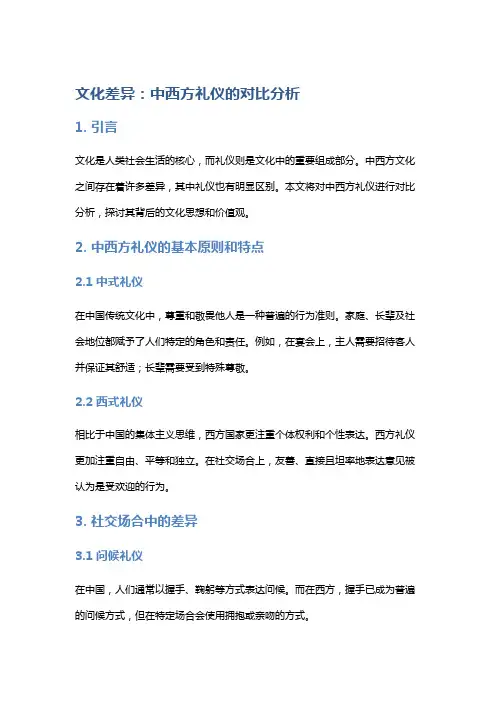
文化差异:中西方礼仪的对比分析1. 引言文化是人类社会生活的核心,而礼仪则是文化中的重要组成部分。
中西方文化之间存在着许多差异,其中礼仪也有明显区别。
本文将对中西方礼仪进行对比分析,探讨其背后的文化思想和价值观。
2. 中西方礼仪的基本原则和特点2.1 中式礼仪在中国传统文化中,尊重和敬畏他人是一种普遍的行为准则。
家庭、长辈及社会地位都赋予了人们特定的角色和责任。
例如,在宴会上,主人需要招待客人并保证其舒适;长辈需要受到特殊尊敬。
2.2 西式礼仪相比于中国的集体主义思维,西方国家更注重个体权利和个性表达。
西方礼仪更加注重自由、平等和独立。
在社交场合上,友善、直接且坦率地表达意见被认为是受欢迎的行为。
3. 社交场合中的差异3.1 问候礼仪在中国,人们通常以握手、鞠躬等方式表达问候。
而在西方,握手已成为普遍的问候方式,但在特定场合会使用拥抱或亲吻的方式。
3.2 言辞和声音中文是一种尊敬他人的语言,通常使用比较委婉、客气的措辞。
相反,在英语中,直接、简明扼要的表达方式被认为是更有效和高效的沟通。
3.3 餐桌礼仪中国和西方各有其自己独特的餐桌礼仪。
例如,在中国餐桌上,主人更注重对客人的照顾和关心;而在西方,个人空间和隐私权被尊重。
4. 文化背景与价值观4.1 中式礼仪背后的文化思想中国传统礼仪注重家族和社会秩序。
服从权威、保持谦虚谨慎且避免直接冲突被视为为了维持社会稳定必要的行为准则。
4.2 西式礼仪背后的文化思想西方文化倾向于强调个人自由、独立和平等。
西方的礼仪更注重尊重对方的个人权利和表达个性。
5. 文化交流中的相互理解和尊重5.1 学习与融合在跨文化交流中,了解并尊重彼此的文化差异是至关重要的。
通过学习对方的礼仪和价值观,可以促进双方之间更好地沟通和融洽相处。
5.2 常见误解由于缺乏文化知识或对他人文化产生偏见,常常导致误解和冲突。
因此,在进行跨文化交流时应保持开放心态,尽量避免刻板印象和偏见。
6. 结论中西方礼仪在根本原则、行为规范和背后文化思想上存在明显差异。
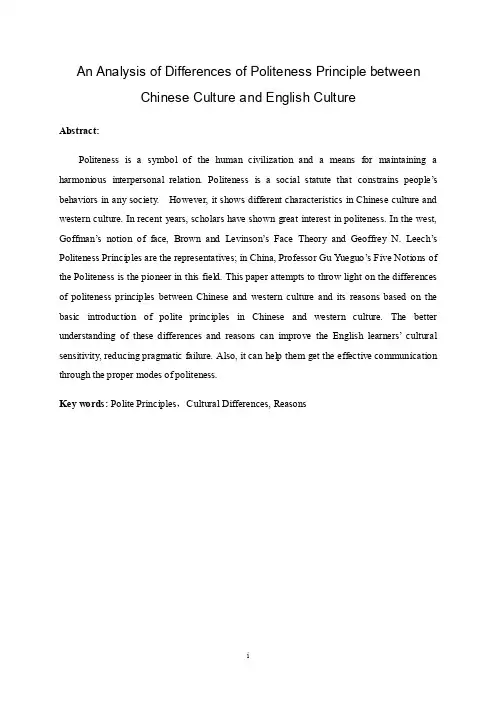
An Analysis of Differences of Politeness Principle betweenChinese Culture and English CultureAbstract:Politeness is a symbol of the human civilization and a means for maintaining a harmonious interpersonal relation. Politeness is a social statute that constrains people‟s behaviors in any society. However, it shows different characteristics in Chinese culture and western culture. In recent years, scholars have shown great interest in politeness. In the west, Goffman‟s notion of face, Brown and Levinson‟s Face Theory and Geoffrey N. Leech‟s Politeness Principles are the representatives; in China, Professor Gu Yueguo‟s Five Notions of the Politeness is the pioneer in this field. This paper attempts to throw light on the differences of politeness principles between Chinese and western culture and its reasons based on the basic introduction of polite principles in Chinese and western culture. The better understanding of these differences and reasons can improve the English learners‟ cultural sensitivity, reducing pragmatic failure. Also, it can help them get the effective communication through the proper modes of politeness.Key words: Polite Principles,Cultural Differences, ReasonsTable of ContentsI. Introduction (1)II. Polite Principles in Chinese and English Culture (2)2.1 Politeness Principles in Chinese Culture (2)2.2 Politeness Principles in English Culture (3)III. Differences of Politeness Principles between Chinese Culture and English Culture (5)3.1 Terms of Address (6)3.2 Thanks and Apology W ords (7)3.3 Contents of the Conversation (7)3.3.1 Compliment and Modest Words (8)3.3.2 Euphemisms and Taboos (8)3.3 .3 Greeting and Farewell Words (9)IV. Reasons of Differences of Politeness Principles between Chinese Culture and English Culture (10)4.1 Different Values Influenced by Cultural Background (10)4.1.1 V alues of Chinese Culture (10)4.1.2 V alues of English Culture (11)4.2 Different Ways of Thinking Influenced by Cultural Backgrounds (12)4.2.1 Chinese Ways of Thinking (12)4.2.2 Western Ways of Thinking (12)V. Conclusion (12)Bibliography (14)Chinese title, abstract, key words (15)An Analysis of Differences of Politeness Principle betweenChinese Culture and English Culture I.IntroductionPoliteness is a universal phenomenon and it can be observed in all languages and cultures. In addition, it plays an important role in human communication: it helps to establish, maintain or consolidate harmonious interpersonal relationships and facilitate social interactions. Politeness as an observable phenomenon is something superficial and a reflection of specific cultural values in the language. Thus, while admitting the universality of politeness, we should realize the cultural characteristics of politeness that is, due to the influences of cultural value orientations, the actual manifestations of politeness and the standards for its judgment differ substantially from culture to culture. To explore politeness, we should consider its cultural specificity and accordingly go into the depth where cultural values are firmly rooted. Only in doing so can we uncover the essence of politeness and successfully account for its cross-cultural differences. We view politeness as one of the major social constraints on human interaction which regulates participants‟ communication behavior by constantly reminding them to take into consideration the feelings of the others (He ziran,2003:57). Politeness is a universal phenomenon, which can be observed in every society. People connect, communicate, and cooperate with each other. To some extent, the globe is a huge society; however, it can operate safe and sound. Except some laws and regulations, the social ethics plays a significant role in maintaining the social order, keeping the harmonious interpersonal relationships, reducing social conflict and misunderstandings. Among the social ethics, politeness is a key factor that can not be neglected. It is of great necessity to consider the feelings of others in order to establish mutual comfort and enhance rapport.With the trend of globalization, people in the diplomatic, intellectual, and business circles have more chances to connect with the foreigners. Through the political, economicaland cultural exchange, people around the world are getting closer and closer. However, more and more problems occur. Realizing the difficulties on our way to globalization, we need to know some basic polite Principle in communication so that a healthier discourse pattern can be adopted (Hu zhuanglin, 2007:98-99). There is a famous saying which goes like this: Courtesy costs nothing. But what is polite in one culture may be impolite in another. Thus, we should do in Rome as Romans do. Polite Principle is further highlighted. Many scholars in growing number attach great importance to the politeness Principles. This paper intends to research into the differences of polite principles between western and Chinese culture and its reasons in the hope to achieve a better understanding of them, to raise our cultural awareness and to promote English-Chinese cross-cultural communication. It also is hoped that it can give some inspirations to the college students and readers.II. Polite Principles in Chinese Culture and English CulturePolite theory is used to accounts for the redressing of the affronts to face posed by face-threatening acts to addressees (Gu Yueguo ,1992:30) . First formulated in 1978 by Penelope Brown and Stephen Levinson, polite theory has since been expanded academia‟s perception of politeness (Wikipedia, part 1). In the English culture, on the basis of Brown and Levinson‟s Face Theory and Grice‟s Cooperative P rinciples, Geoffrey N. Leech (1983:132) developed the face theories and formulated the polite Principles.2.1 Politeness Principles in Chinese CultureDue to different values, different cultural orientations and different ways of thinking, languages are different greatly from one another in expressing and understanding politeness. And in different cultures, the importance of each politeness maxim is different. Some cultural associations in the east (such as China and Japan) prefer modesty maxim; English-speaking countries (especially England) focus on tact maxim; the countries around the Mediterranean prefer generosity maxim to modesty maxim. Based on Leech‟s theory and Chinese politeness features, Prof. Gu Yueguo studies the politeness phenomenon in the C hinese culture. He summarizes the polite Principles with Chinese characteristics.According to Gu Yueguo there are basically four notions underlying the Chineseconception of “politeness”,which reads respectfulness, modesty, attitudinal warmth, and refinement. Respectfulness is self‟s positive appreciation or admiration of other concerning the latter‟s face, social status, and so on. …Modesty‟ can be seen as another way of saying …self-denigration‟. …Attitudinal warmth‟ is self‟s demonstration of kindness, consideration, and hospitality to other. Finally, …refinement‟ refers to self‟s behavior to other wh ich meets certain standards. The four essentials are elaborated into politeness maxims. Gu Yueguo (1992:37) demonstrates four maxims:(1) the self-denigration maxim;(2) the address term maxim;(3) the tact maxim and the generosity maxim;(4) the Principles of Balance, and the Principles of Sincerity;According to the characteristic of Chinese culture, Gu Yueguo(1992:43) has proposed five politeness maxims:(1) Self-denigration Maxim: a). Denigrate self;b). Elevate other;(2) Address Term Maxim, which requires addressing your interlocutor with an appropriate address form;(3) Refinement Maxim, which requires using refined language, including the use of euphemisms and indirectness, and avoid foul language;(4) Agreement Maxim, which maximizes agreement and harmony between interlocutors, and minimizes disagreement between them;(5) Virtues-words-deeds Maxim, which minimizes cost and maximizes benefit to other at the motivational level, and maximizes benefit received and minimizes cost to self at the conversational level.2.2 Politeness Principles in English CultureTalking about the polite principles in English culture, we should know that it mainly includes Brown and Levinson‟s Face Theory and Geoffrey Leech‟s Politeness Principles. These two theories have important roles in politeness principles in English culture.Brown and Levinson‟s influential theory is based on Grice‟s maxim theory and Goffman‟s“face” as the positive social value a person effective ly claims for himself by the line others assume he has taken during a particular contact‟ (Goffman, 1967:51) face can be likened to a person‟s public self-esteem or self-image, which can be damaged, maintained or enhanced in interaction with others (Leo, 2001:57). Brown and Levinson divided the notion of face into positive face and negative face, according to interactants‟ wants. Brown and Levinson define …positive face‟ as the positive and consistent image people have of themselves, and their desire for ap proval. On the other hand, …negative face‟ is “the basic claim to territories, personal preserves, and rights to non-distraction” (Brown and Levinson, 1987:61). Deviations from Gricean maxims are motivated by employing strategies to counteract so-called “f ace-threatening acts” (FTAs) by using these politeness strategies speakers communicate both their primary message and also the message that they intend to be polite, which has the status of a Gricean conversational implicature (Leo, 2001:57).Leech divides the Politeness Principles into six different maxims:(1) Act maxim: a) Minimize cost to otherb) Maximize benefit to other(2) Generosity maxim: a) Minimize benefit to self.b) Maximize cost to self.(3) Approbation maxim: a) Minimize dispraise of other.b) Maximize praise of other.(4) Modesty maxim: a) Minimize praise of self.b) Maximize dispraise of self(5) Agreement maxim: a) Minimize disagreement between self and other.b) Maximize agreement between self and other.(6) Sympathy maxim: a) Minimize antipathy between self and other.b) Maximize sympathy between self and other.(Leech 1983:132).Leech‟s Polite Principle is built on the basis of the concept of “cost” and “benefit”. Costrefers to the inconvenience or loss that the content of the interaction brings to the speaker and the hearer; benefit means the convenience or the advantage to the speaker and the hearer. The degree of politeness is consistent with the scale of indirectness, which can be observed superficially. As a matter of fact, the level of politeness is in contrast to other‟s cost or self‟s benefit. Generally speaking, the more the content of interaction benefits the hearer, the less the speaker‟s goods, thus the communication is politer. Otherwise, it is impolite. This is the essence of the phenomenon. This is why people choose to use euphemism or the indirect language to minimize the impolite speech. For example, when a woman is pregnant, it is impolite to say you are pregnant directly. However, it is better to say “She has canceled all her social engagements.” or “She is in an interesting condition.” The six maxims of Leech‟s Politeness Principles are interrelated with one another, restrained with one another and can not be understood in isolation.According to Leech, not all the maxims and sub-maxims are equally important. Of all the maxims, Tact Maxim is more powerful on conversational behavior than Generosity Maxim and Approbation Maxim is more powerful than Modesty Maxim. In all maxims, part a) is more important than part b) as it emphasizes not to impose or disagree in conversation (Sara, 2003:129). In all, the Principles are not motivated by the need of the cross-cultural communication; they seem to be derived from strategies used by English speakers. In addition, these Principles do not always apply to other culture. Though some of the maxims can be applied to other cultures, the differences still exist. In the English culture, individualism is the center of their value system. The privacy, freedom and personal realization are sacred and inviolable. Tact Maxim is frequently used. Even when the parents “order” their children to do something, they will follow the tact maxim in order not to threaten their children‟s nega tive face. People often use indirect and tactful language.For example:Would you please pass me the salt?Would you mind passing me the salt?Could you possibly pass me the salt?I was wondering if you could pass me the salt?…Some of the people can give order, request, suggestion or even threatening, while others have no choice but to accept the instructions unconditionally. In a word, Leech‟s Politeness Principle is measured by the speaker‟s and the hearer‟s benefit and cost.III. Differences of Politeness Principles between Chinese Culture and English CultureStemming from different cultural backgrounds, the Chinese politeness Principle and the English politeness Principle may have different response and explanation to the same politeness phenomenon. Different cultures may focus on different maxims. In the English-speaking countries, the tact maxim is the most important, which forms the core of the English language and culture. People usually follow this maxim when they perform the speech act, such as requesting, ordering or warning. While in the Chinese society, the self-denigration maxim is the core. This well explains why whenever Chinese people hear the compliment, they would negate the compliment and depreciate themselves to show modesty. In addition, we may observed that the Chinese place more emphasis in their talk on the needs of the group rather than those of the individual, but we can not conclude on the basis of these observations alone that they are genuine more altruistic than members of o ther communities. The major differences between Chinese and English politeness Principles are discussed as follows.3.1 Terms of AddressThe differences between the Chinese and English politeness Principles are also reflected in the terms of address. Every language has its own specific address system and its usage is closely related with the cultural background. When people greet, people in the English-speaking country use the terms of address as well. The terms of address show the social relationships between people. From top to bottom, there are social ranks, high or low, young and old. The change of the terms of address means the change of the relationship. Affected by the social structure, traditional ethics, blood relation and religious factors, Chinese address system is rather complicated than those of the English-speaking countries.Chinese people like to use the blood relations to call their family members and relatives; what‟s more, they call non-family friends and relatives, which is rare in the English-speaking countries. Owning to its social structure and cultural orientation, the interpersonal relationship of the English-speaking countries is totally different from that of Chinese. So the use of the address is varied as well. Generally speaking, English people like to call each other‟s name. This fully shows the cultural orientation of equality. Friends usually address each other‟s name (not including the family name). On the formal occasion, “Mr”, “Miss”, “Mrs” and some other appellations are often used. There are a few titles can be used to address others, except Doctor, Professor, President, etc. the terms of address in the Chinese culture is rather complicated. Chinese people like to add the title before someone‟s family name, such as Director Huang, Manager Ma, or Deputy Li. Thus, the addresses that Chinese people think is polite may be rude according to the English culture. For instant we add “small” or “old” before one‟s family name. This is considered rude in the English-speaking countries. People do not like to be named with words like small or old. When referring to old people, they use the senior citizen instead. For instance, in China, if we call someone “老李”, it actually shows ours respect for him. But if you call a foreigner “Old Brown”, he may think you are impolite or rude.3.2 Thanks and Apology W ordsThe words of thanks belong to the polite language. When one spends time and energy in helping another, it is the basic politeness for one to express his gratitude to the other part. In the aspect of “Thanks”, the English use “thank you” more often than the Chinese. For the English, everyone says “Thank you” even the family members have no exception. While in China, the more intimate the relationship is, the less they say “thank you” to each other. Saying “thank you” is considered to enlarge the interpersonal distance. When people are praised by others, they do not usually say “thank you”, so as not to leave an impression of immodesty. The differences also exist in different culture for using the words of apology. But Chinese people do not apologize very frequently. In China, when doing the wrong things or making mistakes, the authority and the elder do not need to apologize. It is the embodiment ofthe power. There are also some young people, even though their parents have done a lot for them, they seldom say “thank you” to their parents. Westerners consider attitudes like this as rude and unreasonable.3.3 Contents of the ConversationPeople who use different language may hold different views about the world. About one thing, people of different cultural backgrounds may have different ideas. For the English value, “individualism” is the core. They advocate individualism. Individual rights and the private property are inviolable, while the Chinese people appreciate collectivism, promoting mutual friendship. The English people focus on the concept of privacy, but the Chinese people prefer the intimacy. Respecting for individual privacy is one of the major values of the English ideology. In daily life, the English do not want to interfere in other‟s private business, particularly with regard to age, family, income, marital status. In China, on the contrary, nothing is private. People do not think these acts are intrusive other‟s private space. In their mind, it is natural and ordinary. In fact, these acts are beyond the English people‟s psychological limit and privacy. This may fail to achieve the communicative purpose and it may lead to other‟s indifference and alienation.3.3.1 Compliment and Modest W ordsLeech's Modesty maxim is equivalent to part of Gu‟s self-denigration maxim. When referring to self, one should depreciate oneself and be modest. When referring to other, one should show one‟s appreciation and respect to other. For the usag e of compliment and modest words, the Chinese and the English have significant differences. In the English-speaking countries, people usually adopt agreement maxim when they are praised. They seldom negate the praise in order not embarrass others. For example, an actor just finished his performance, one of his friend said to him: “Hey, you really did a good job tonight!” The actor may answer: “Well, thank you very much.” However, in China, it is the other way round, in the face of such recognition; one can not be so straightforward. It is customary to use "self-negation" or "deny" approach. China's historical and cultural traditions emphasize collectivism, resulting in a unique habit of modesty. In this case the Europeans may think Chinese are impolite becausethey have been rejected bluntly.3.3.2 Euphemisms and TaboosThe refined language maxim requires not using offensive language, being more tactful and less straightforward. In order to avoid rude words in the English language there are a number of taboo words and euphemisms. People use those words to avoid direct reference to something unpleasant or something embarrassing. These taboo words and euphemism can be widely used. They are the products of the conventional social orders and politeness Principles. To some degree, Chinese and English are the same in the use of taboo words. For example, talking about the body organs and sex on the public occasions is rude. The differences lie in the following aspects. The English do not like to ask people‟s privacy, such as age, income, marital status, political orientation, religious belief and so on. These inquiries may be considered inappropriate, offensive and unrespectable for other‟s privacy. However, it is common in China. If your friend introduces another friend to you, you may ask your new friend “where is your hometown? What do you do?” or “where do you live?” The common interpersonal communication may look weird in the foreigners‟ eyes. It is, to some degree, an act of invading their privacy rights.3.3 .3 Greeting and Farewell W ordsIt is natural to greet when people meet. The expressions may vary from one culture to another. In the English-speaking countries, there are some fixed greetings, such as: How are you? (In fact, people are not really care about other‟s health status), replies often go like this: Fine, thank you (Regardless of whether the listener really feel good). For greeting, Chinese people often say: "do lunch", "Where to", "Where to go" and so on, we think those expressions are very natural, it is just greeting. Hearing the Chinese style of greeting, foreigners may have a misunderstanding: Chinese people like to mind other‟s business. Respectively the English people often say: "Goodbye. Bye-bye. So long or See you later, tomorrow on the next morning". It is equivalent to Chinese like "Good-bye, Bye, now see, See you tomorrow, or see you next Monday." Chinese people sometimes say so. Although in the English-speaking countries, biding farewell is roughly the same, yet there are differentways to bid farewell. Compared with the English, Chinese are more subtle. Although the Chinese and the English are more or less the same in the farewell words, Chinese are more reserved.IV. Reasons of Differences of Politeness Principles between Chinese Culture and English CultureDifferent cultural factors may result in cultural differences, and consequently, the acknowledgment of the factors affecting the cultural differences will facilitate the understanding of such differences. However, it is impossible to cover all of the factors in this thesis, so the factors discussed here are some important ones. So, we can see there are many differences of politeness principles between the western and Chinese culture as we discussed in chapter three. In this chapter, we will talk about the main reasons from their different families‟ features and concepts as well as different values between them.4.1 Different Values Influenced by Cultural BackgroundsAnother cultural reason for differences between China and western countries is different value under the different cultural backgrounds. In the following, we will talk about the values in Chinese culture and western culture.4.1.1 Values of Chinese CultureIn spring and autumn and Warring‟s periods of China, Confucianis m, Taoism and other ideologies emerged. As different ideologies developed and combated each other, the basic framework of Chinese civilization was established. And then Confucianism became the foundation stone of Chinese philosophy system. Confucianism‟s c entral doctrine is that of the virtue of Ren. What is Ren? Ren is translated variously as goodness, benevolence, humanity and human-heartedness. In short, Ren means affection and love. For more than two thousand years it has molded and shaped the civilization of China and exerted a profound influence upon almost one fourth of the human race. The core of the Chinese value has some relationship with the Confucianism. That is the well-known Five Relationships: ruler-minister, father-son, husband-wife, elder-younger brother and friend-friend. This was explained as“There should be affection between father and son, righteous sense of duty between ruler and minister, division of function between husband and wife, stratification between old and young, and good fait h between friends.” During the more than two thousand years of the feudal period, the ruling class arranges every thing by this relationship, and then formed a class society. In this kind of society, a minister owes loyalty to his ruler, and a child filial respect to his parent. As a result, humanity is neglected and people have no equality. In recent years, this kind of relations has changed greatly. People in China also hope to have an equal status, but the Confucianism is still rooted in people‟s mind, a nd it needs a long time to realize to be truly equal.4.1.2 Values of English CultureThe concept of Chinese values is usually placed in opposition with English values. Therefore, it is necessary to determine how people define English values. Some have stated that the modern English value system originated in Victorian England, and describe it as social norms and behaviors well-known in European people during that time. The core of English values is individualism. English values have three levels: 1) physical level –science, technology, business, public administration, and modern capitalist economics; 2) conceptual level – equal opportunity, the role of law; and time management; and 3) core values – open debate, equality, balance of power, Free speech and democracy( Zhangzhanyi, 1990:103). Different from China, religion plays an important role in English culture. The English speaking countries are generally considered as religious countries, and among all the religious groups by which people seek to worship, Christianity is by far the most influential in the west. Almost every phase of man‟s life is touched by religion, so much so that it has become part and parcel of English culture. Christianity is the religion based on the life and teaching of Jesus Christ, who is the founder of Christianity. According to the doctrine of Christianity, the Trinity is the union of the three forms of God, the Son and the Holy Spirit. Although in the English countries religion provides the customs and ceremonies that mark lif e‟s most important events-birth, coming of age, marriage, and death, religion has declined in importance in terms ofinfluencing behavior and philosophical outlook. Now when people need personal advice, they usually turn to psychiatrists or to professional counselors rather than to Fathers for help. Although, the power of the church cannot compare with the past, it still influences many aspects of people's daily life. For example, there are a few important festivals in the English countries is concern with Jesus Christ. Christmas day is a festival in celebration of the birth of the Jesus Christ on Dec.25 (Chenlinhua, 1998:67).4.2 Different W ays of Thinking Influenced by Cultural Backgrounds4.2.1 Chinese W ays of ThinkingChinese people lived in a vast and rich land in East Asian Continent in the North Temperate Zone. In ancient times, they enjoyed the favor from nature without too much fear. The stable agricultural society made Chinese people in harmony with nature. On one hand, Chinese people were clear that everything came from nature, and the relationship between man and nature was very close; on the other hand, nature was so mysterious to them that they were satisfied with what they had got, and they thought their existence relied on the bounty of nature. This kind of viewpoint resulted in the fact that Chinese people lacked the feelings of hostility to nature, and tried to seek for the harmony between man and nature. They made efforts in the stability of society and happiness of people. As for the traditional Chinese thought, Confucianist thought originated from the semi-closed continental surroundings and the small peasant economy. What‟s more, the Taoism influences Chinese thought pattern as well. LaoZi holds that the world is full of opposites and contradictions. In order to eliminate them to come to harmony, man must get to the level of “Wu Wei”, which derived from a point of Dao and De. Influenced by the above Chinese philosophy, Chinese thought pattern tend to be synthetic and subjective. Chinese way of thinking decides Chinese people express their polite culture more directly.4.2.2 Western Ways of ThinkingContrary to the Chinese, English speaking people usually consider the objective things。
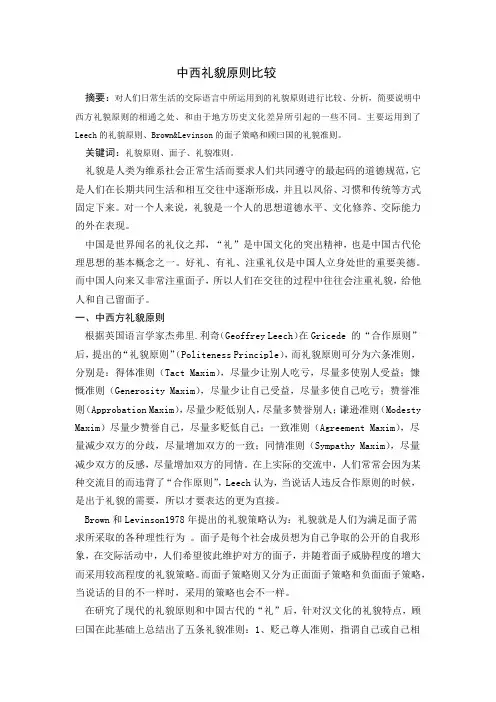
中西礼貌原则比较摘要:对人们日常生活的交际语言中所运用到的礼貌原则进行比较、分析,简要说明中西方礼貌原则的相通之处、和由于地方历史文化差异所引起的一些不同。
主要运用到了Leech的礼貌原则、Brown&Levinson的面子策略和顾曰国的礼貌准则。
关键词:礼貌原则、面子、礼貌准则。
礼貌是人类为维系社会正常生活而要求人们共同遵守的最起码的道德规范,它是人们在长期共同生活和相互交往中逐渐形成,并且以风俗、习惯和传统等方式固定下来。
对一个人来说,礼貌是一个人的思想道德水平、文化修养、交际能力的外在表现。
理思想的基本概念之一。
好礼、有礼、注重礼仪是中国人立身处世的重要美德。
而中国人向来又非常注重面子,所以人们在交往的过程中往往会注重礼貌,给他人和自己留面子。
一、中西方礼貌原则根据英国语言学家杰弗里.利奇(Geoffrey Leech)在Gricede 的“合作原则”后,提出的“礼貌原则”(Politeness Principle),而礼貌原则可分为六条准则,分别是:得体准则(Tact Maxim),尽量少让别人吃亏,尽量多使别人受益;慷慨准则(Generosity Maxim),尽量少让自己受益,尽量多使自己吃亏;赞誉准则(Approbation Maxim),尽量少贬低别人,尽量多赞誉别人;谦逊准则(Modesty Maxim)尽量少赞誉自己,尽量多贬低自己;一致准则(Agreement Maxim),尽量减少双方的分歧,尽量增加双方的一致;同情准则(Sympathy Maxim),尽量减少双方的反感,尽量增加双方的同情。
在上实际的交流中,人们常常会因为某种交流目的而违背了“合作原则”,Leech认为,当说话人违反合作原则的时候,是出于礼貌的需要,所以才要表达的更为直接。
Brown和Levinson1978年提出的礼貌策略认为:礼貌就是人们为满足面子需求所采取的各种理性行为。
面子是每个社会成员想为自己争取的公开的自我形象,在交际活动中,人们希望彼此维护对方的面子,并随着面子威胁程度的增大而采用较高程度的礼貌策略。

中西礼貌用语对比分析礼貌是人们在社交交往中表现出来的一种尊重和关心他人的态度。
尽管中西方文化有很多差异,但礼貌与尊重他人的原则在各个文化中都是普遍存在的。
本文将对中西礼貌用语进行对比分析,以便更好地了解中西方文化的差异。
中西方在问候和道别方面存在着一些差异。
在中文中,我们常用的问候语是“你吃了吗?”这是一种表达关心和关注他人健康的方式。
而在西方,人们通常会问候“你好吗?”或者是“最近怎么样?”这种问候方式更加注重个人的感受和最近的情况。
在感谢和道歉方面也存在一些差异。
在中文中,我们常用的感谢用语是“谢谢”,而在西方,人们通常会使用“thank you”来表示感谢之情。
在道歉方面,中文中常用的道歉用语是“对不起”或者“不好意思”,而在西方,人们通常会使用“I’m sorry”来表达道歉之意。
在请求和邀请方面也有一些不同。
在中文中,我们通常会使用委婉的方式来表达请求,而在西方,人们通常会更加直接地向他人表达自己的需求。
在邀请方面,中文中常用的邀请用语是“请你来...”,而在西方,人们通常会使用“Would you like to come...”来表达邀请之意。
中西方在对待长辈和陌生人方面也存在一些差异。
在中文中,我们通常会使用尊敬的称呼来称呼长辈和陌生人,比如“先生”、“女士”等。
而在西方,人们通常会直接使用对方的名字来称呼他人,而不加任何修饰词。
这显示了中西方文化中对长辈和陌生人的态度和尊重程度的差异。
中西礼貌用语在问候和道别、感谢和道歉、请求和邀请以及对待长辈和陌生人方面存在一些差异。
虽然存在这些差异,但中西方文化都注重礼貌和尊重他人的原则,这是人与人之间和谐相处的基础。
通过了解和尊重对方的文化差异,我们可以更好地理解和交流,促进不同文化之间的互相理解和友谊。
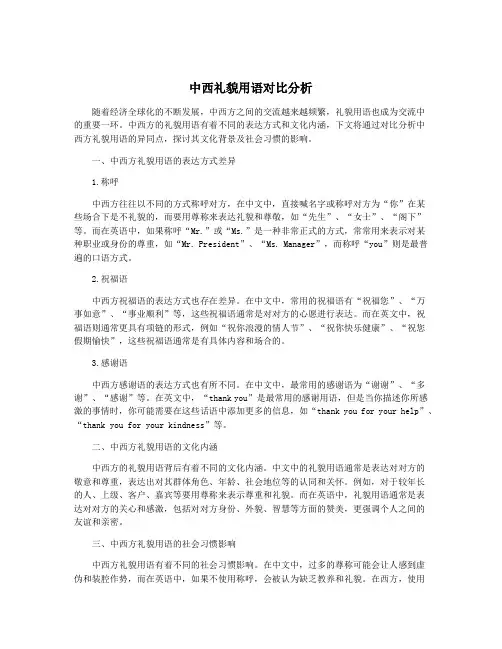
中西礼貌用语对比分析随着经济全球化的不断发展,中西方之间的交流越来越频繁,礼貌用语也成为交流中的重要一环。
中西方的礼貌用语有着不同的表达方式和文化内涵,下文将通过对比分析中西方礼貌用语的异同点,探讨其文化背景及社会习惯的影响。
一、中西方礼貌用语的表达方式差异1.称呼中西方往往以不同的方式称呼对方,在中文中,直接喊名字或称呼对方为“你”在某些场合下是不礼貌的,而要用尊称来表达礼貌和尊敬,如“先生”、“女士”、“阁下”等。
而在英语中,如果称呼“Mr.”或“Ms.”是一种非常正式的方式,常常用来表示对某种职业或身份的尊重,如“Mr. President”、“Ms. Manager”,而称呼“you”则是最普遍的口语方式。
2.祝福语中西方祝福语的表达方式也存在差异。
在中文中,常用的祝福语有“祝福您”、“万事如意”、“事业顺利”等,这些祝福语通常是对对方的心愿进行表达。
而在英文中,祝福语则通常更具有项链的形式,例如“祝你浪漫的情人节”、“祝你快乐健康”、“祝您假期愉快”,这些祝福语通常是有具体内容和场合的。
3.感谢语中西方感谢语的表达方式也有所不同。
在中文中,最常用的感谢语为“谢谢”、“多谢”、“感谢”等。
在英文中,“thank you”是最常用的感谢用语,但是当你描述你所感激的事情时,你可能需要在这些话语中添加更多的信息,如“thank you for your help”、“thank you for your kindness”等。
二、中西方礼貌用语的文化内涵中西方的礼貌用语背后有着不同的文化内涵。
中文中的礼貌用语通常是表达对对方的敬意和尊重,表达出对其群体角色、年龄、社会地位等的认同和关怀。
例如,对于较年长的人、上级、客户、嘉宾等要用尊称来表示尊重和礼貌。
而在英语中,礼貌用语通常是表达对对方的关心和感激,包括对对方身份、外貌、智慧等方面的赞美,更强调个人之间的友谊和亲密。
三、中西方礼貌用语的社会习惯影响中西方礼貌用语有着不同的社会习惯影响。
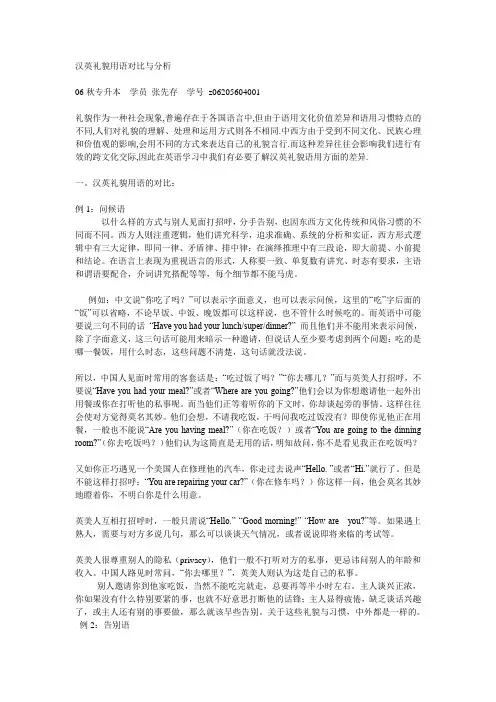
汉英礼貌用语对比与分析06秋专升本学员张先存学号z06205604001礼貌作为一种社会现象,普遍存在于各国语言中,但由于语用文化价值差异和语用习惯特点的不同,人们对礼貌的理解、处理和运用方式则各不相同.中西方由于受到不同文化、民族心理和价值观的影响,会用不同的方式来表达自己的礼貌言行.而这种差异往往会影响我们进行有效的跨文化交际,因此在英语学习中我们有必要了解汉英礼貌语用方面的差异.一。
汉英礼貌用语的对比:例1:问候语以什么样的方式与别人见面打招呼,分手告别,也因东西方文化传统和风俗习惯的不同而不同。
西方人则注重逻辑,他们讲究科学,追求准确、系统的分析和实证,西方形式逻辑中有三大定律,即同一律、矛盾律、排中律;在演绎推理中有三段论,即大前提、小前提和结论。
在语言上表现为重视语言的形式,人称要一致、单复数有讲究、时态有要求,主语和谓语要配合,介词讲究搭配等等,每个细节都不能马虎。
例如:中文说“你吃了吗?”可以表示字面意义,也可以表示问候,这里的“吃”字后面的“饭”可以省略,不论早饭、中饭、晚饭都可以这样说,也不管什么时候吃的。
而英语中可能要说三句不同的话“Have you had your lunch/super/dinner?” 而且他们并不能用来表示问候,除了字面意义,这三句话可能用来暗示一种邀请,但说话人至少要考虑到两个问题:吃的是哪一餐饭,用什么时态,这些问题不清楚,这句话就没法说。
所以,中国人见面时常用的客套话是:“吃过饭了吗?”“你去哪儿?”而与英美人打招呼,不要说“Have you had your meal?”或者“Where are you going?”他们会以为你想邀请他一起外出用餐或你在打听他的私事呢。
而当他们正等着听你的下文时,你却谈起旁的事情。
这样往往会使对方觉得莫名其妙。
他们会想,不请我吃饭,干吗问我吃过饭没有?即使你见他正在用餐,一般也不能说“Are you having meal?”(你在吃饭?)或者“You are going to the dinning room?”(你去吃饭吗?)他们认为这简直是无用的话,明知故问,你不是看见我正在吃饭吗?又如你正巧遇见一个美国人在修理他的汽车,你走过去说声“Hello. ”或者“Hi.”就行了。
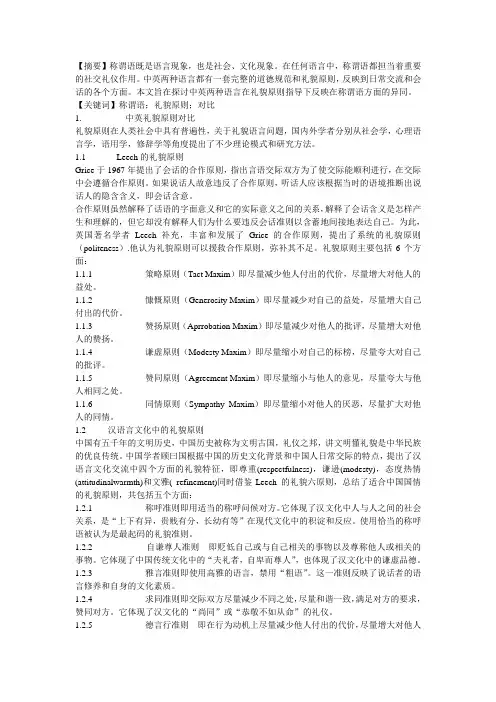
【摘要】称谓语既是语言现象,也是社会、文化现象。
在任何语言中,称谓语都担当着重要的社交礼仪作用。
中英两种语言都有一套完整的道德规范和礼貌原则,反映到日常交流和会话的各个方面。
本文旨在探讨中英两种语言在礼貌原则指导下反映在称谓语方面的异同。
【关键词】称谓语;礼貌原则;对比1. 中英礼貌原则对比礼貌原则在人类社会中具有普遍性,关于礼貌语言问题,国内外学者分别从社会学,心理语言学,语用学,修辞学等角度提出了不少理论模式和研究方法。
1.1 Leech的礼貌原则Grice于1967年提出了会话的合作原则,指出言语交际双方为了使交际能顺利进行,在交际中会遵循合作原则。
如果说话人故意违反了合作原则,听话人应该根据当时的语境推断出说话人的隐含含义,即会话含意。
合作原则虽然解释了话语的字面意义和它的实际意义之间的关系,解释了会话含义是怎样产生和理解的,但它却没有解释人们为什么要违反会话准则以含蓄地间接地表达自己。
为此,英国著名学者Leech补充,丰富和发展了Grice的合作原则,提出了系统的礼貌原则(politeness).他认为礼貌原则可以援救合作原则,弥补其不足。
礼貌原则主要包括6个方面:1.1.1 策略原则(Tact Maxim)即尽量减少他人付出的代价,尽量增大对他人的益处。
1.1.2 慷慨原则(Generosity Maxim)即尽量减少对自己的益处,尽量增大自己付出的代价。
1.1.3 赞扬原则(Aprrobation Maxim)即尽量减少对他人的批评,尽量增大对他人的赞扬。
1.1.4 谦虚原则(Modesty Maxim)即尽量缩小对自己的标榜,尽量夸大对自己的批评。
1.1.5 赞同原则(Agreement Maxim)即尽量缩小与他人的意见,尽量夸大与他人相同之处。
1.1.6 同情原则(Sympathy Maxim)即尽量缩小对他人的厌恶,尽量扩大对他人的同情。
1.2 汉语言文化中的礼貌原则中国有五千年的文明历史,中国历史被称为文明古国,礼仪之邦,讲文明懂礼貌是中华民族的优良传统。
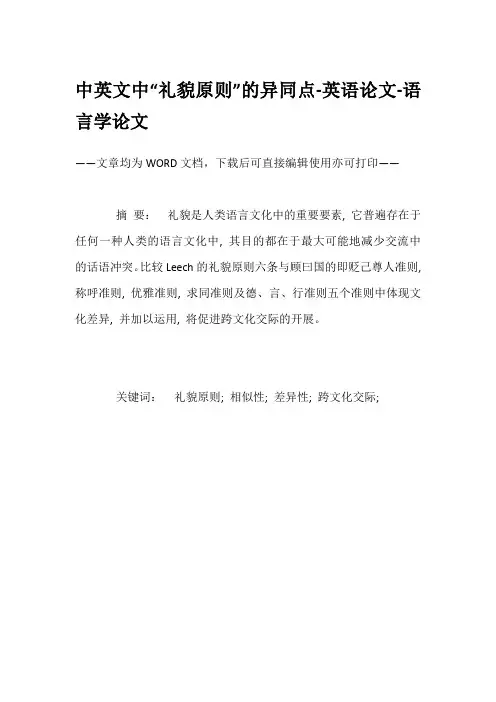
中英文中“礼貌原则”的异同点-英语论文-语言学论文——文章均为WORD文档,下载后可直接编辑使用亦可打印——摘要:礼貌是人类语言文化中的重要要素, 它普遍存在于任何一种人类的语言文化中, 其目的都在于最大可能地减少交流中的话语冲突。
比较Leech的礼貌原则六条与顾曰国的即贬己尊人准则, 称呼准则, 优雅准则, 求同准则及德、言、行准则五个准则中体现文化差异, 并加以运用, 将促进跨文化交际的开展。
关键词:礼貌原则; 相似性; 差异性; 跨文化交际;礼貌是人类语言文化中的重要要素, 它普遍存在于任何一种人类的语言文化中, 其目的都在于最大可能地减少交流中的话语冲突。
三十多年来, 随着语用学的快速发展, 关于语言使用过程中的礼貌问题逐渐演变为一大研究主题, 就当前的研究成果来看, 英汉两种语言文化在礼貌语用方面受到文化因素的制约最多。
一、国内外研究现状1. 国外研究现状基于语言表达的礼貌原则理论, 是在国外语用学研究过程中逐渐发展并完善起来的。
20世纪50年代, 美国学者戈夫曼在其着作《Anchor Books》(1967) 中从社会学角度提出了面子行为理论, 建立了语言礼貌原则的雏形。
1987年, 英国学者Brown和Levinson根据Goffman的解释进一步提出了面子保全论, 指出礼貌是社会中具有正常交际能力的人, 即具有面子需求的理性人, 为满足其面子需求而采取的各种理性行为。
在20世纪80年代, 英国语言学家利奇出版了自己的着作《Principles of Pragmatics》(1983) , 在这本书中, 利奇在合作原则的基础上, 从修辞学、语体学的角度出发, 提出了六条着名的礼貌原则。
Leech的礼貌原则概括地说就是在其他条件相同的情况下, 把不礼貌意思的表达减弱到最低限度, 把礼貌意思的表达增大到最高限度。
2. 国内研究现状在我国, 顾曰国是该领域研究的第一人, 在1992年《外语教学与研究》第四期刊物上, 他发表了论文《语用与文化》。
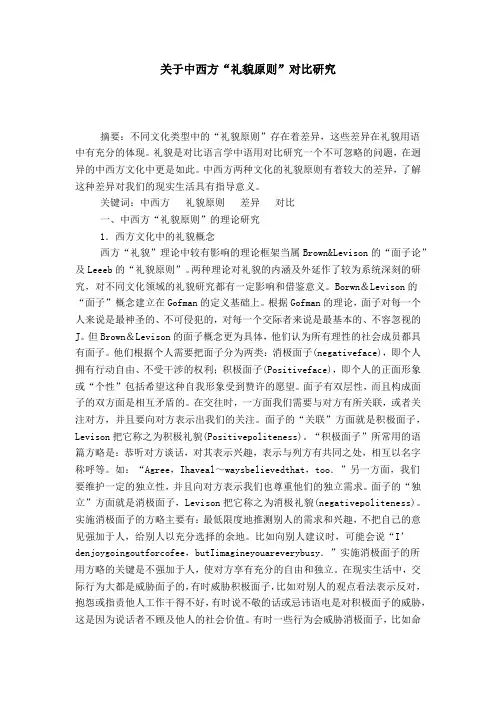
关于中西方“礼貌原则”对比研究摘要:不同文化类型中的“礼貌原则”存在着差异,这些差异在礼貌用语中有充分的体现。
礼貌是对比语言学中语用对比研究一个不可忽略的问题,在迥异的中西方文化中更是如此。
中西方两种文化的礼貌原则有着较大的差异,了解这种差异对我们的现实生活具有指导意义。
关键词:中西方礼貌原则差异对比一、中西方“礼貌原则”的理论研究1.西方文化中的礼貌概念西方“礼貌”理论中较有影响的理论框架当属Brown&Levison的“面子论”及Leeeb的“礼貌原则”。
两种理论对礼貌的内涵及外延作了较为系统深刻的研究,对不同文化领域的礼貌研究都有一定影响和借鉴意义。
Borwn&Levison的“面子”概念建立在Gofman的定义基础上。
根据Gofman的理论,面子对每一个人来说是最神圣的、不可侵犯的,对每一个交际者来说是最基本的、不容忽视的J。
但Brown&Levison的面子概念更为具体,他们认为所有理性的社会成员都具有面子。
他们根据个人需要把面子分为两类:消极面子(negativeface),即个人拥有行动自由、不受干涉的权利;积极面子(Positiveface),即个人的正面形象或“个性”包括希望这种自我形象受到赞许的愿望。
面子有双层性,而且构成面子的双方面是相互矛盾的。
在交往时,一方面我们需要与对方有所关联,或者关注对方,并且要向对方表示出我们的关注。
面子的“关联”方面就是积极面子,Levison把它称之为积极礼貌(Positivepoliteness)。
“积极面子”所常用的语篇方略是:恭听对方谈话,对其表示兴趣,表示与列方有共同之处,相互以名字称呼等。
如:“Agree,Ihaveal~waysbelievedthat,too.”另一方面,我们要维护一定的独立性,并且向对方表示我们也尊重他们的独立需求。
面子的“独立”方面就是消极面子,Levison把它称之为消极礼貌(negativepoliteness)。
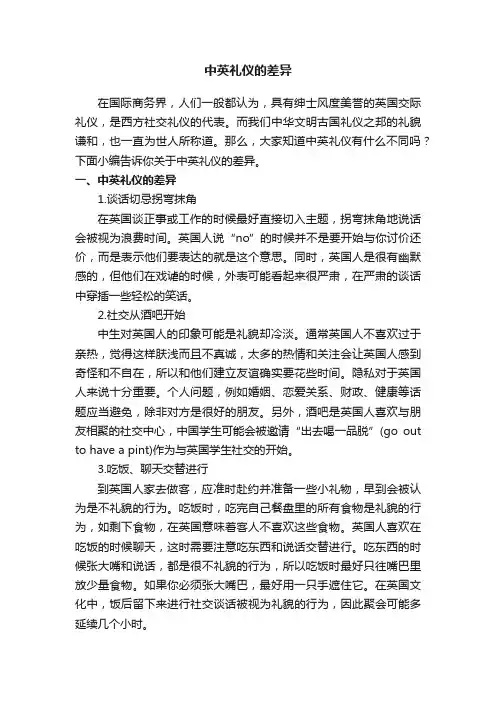
中英礼仪的差异在国际商务界,人们一般都认为,具有绅士风度美誉的英国交际礼仪,是西方社交礼仪的代表。
而我们中华文明古国礼仪之邦的礼貌谦和,也一直为世人所称道。
那么,大家知道中英礼仪有什么不同吗?下面小编告诉你关于中英礼仪的差异。
一、中英礼仪的差异1.谈话切忌拐弯抹角在英国谈正事或工作的时候最好直接切入主题,拐弯抹角地说话会被视为浪费时间。
英国人说“no”的时候并不是要开始与你讨价还价,而是表示他们要表达的就是这个意思。
同时,英国人是很有幽默感的,但他们在戏谑的时候,外表可能看起来很严肃,在严肃的谈话中穿插一些轻松的笑话。
2.社交从酒吧开始中生对英国人的印象可能是礼貌却冷淡。
通常英国人不喜欢过于亲热,觉得这样肤浅而且不真诚,太多的热情和关注会让英国人感到奇怪和不自在,所以和他们建立友谊确实要花些时间。
隐私对于英国人来说十分重要。
个人问题,例如婚姻、恋爱关系、财政、健康等话题应当避免,除非对方是很好的朋友。
另外,酒吧是英国人喜欢与朋友相聚的社交中心,中国学生可能会被邀请“出去喝一品脱”(go out to have a pint)作为与英国学生社交的开始。
3.吃饭、聊天交替进行到英国人家去做客,应准时赴约并准备一些小礼物,早到会被认为是不礼貌的行为。
吃饭时,吃完自己餐盘里的所有食物是礼貌的行为,如剩下食物,在英国意味着客人不喜欢这些食物。
英国人喜欢在吃饭的时候聊天,这时需要注意吃东西和说话交替进行。
吃东西的时候张大嘴和说话,都是很不礼貌的行为,所以吃饭时最好只往嘴巴里放少量食物。
如果你必须张大嘴巴,最好用一只手遮住它。
在英国文化中,饭后留下来进行社交谈话被视为礼貌的行为,因此聚会可能多延续几个小时。
4.凡事情要预约在英国的生活中与人交往还要注意,拜访朋友前要提前通知对方,不速之客会让人讨厌。
应当尽量避免在晚上10时后打电话到别人家,晚上11点后打电话很可能被英国人当作有紧急事件。
英国的许多服务都需要提前预约,如看医生、理发、美容、配眼镜等。
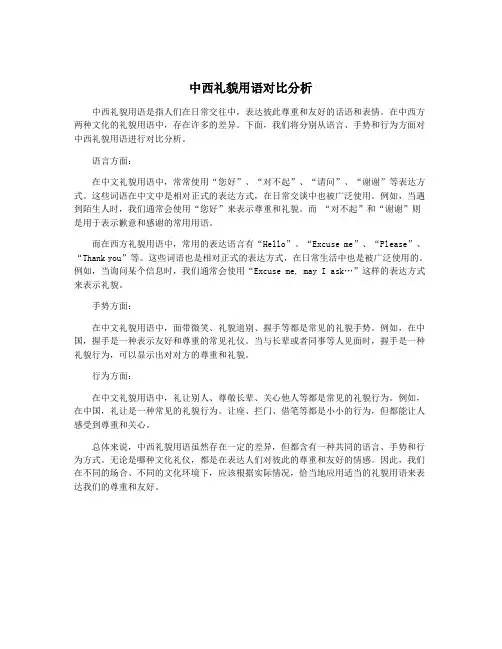
中西礼貌用语对比分析中西礼貌用语是指人们在日常交往中,表达彼此尊重和友好的话语和表情。
在中西方两种文化的礼貌用语中,存在许多的差异。
下面,我们将分别从语言、手势和行为方面对中西礼貌用语进行对比分析。
语言方面:在中文礼貌用语中,常常使用“您好”、“对不起”、“请问”、“谢谢”等表达方式。
这些词语在中文中是相对正式的表达方式,在日常交谈中也被广泛使用。
例如,当遇到陌生人时,我们通常会使用“您好”来表示尊重和礼貌。
而“对不起”和“谢谢”则是用于表示歉意和感谢的常用用语。
而在西方礼貌用语中,常用的表达语言有“Hello”、“Excuse me”、“Please”、“Thank you”等。
这些词语也是相对正式的表达方式,在日常生活中也是被广泛使用的。
例如,当询问某个信息时,我们通常会使用“Excuse me, may I ask…”这样的表达方式来表示礼貌。
手势方面:在中文礼貌用语中,面带微笑、礼貌道别、握手等都是常见的礼貌手势。
例如,在中国,握手是一种表示友好和尊重的常见礼仪。
当与长辈或者同事等人见面时,握手是一种礼貌行为,可以显示出对对方的尊重和礼貌。
行为方面:在中文礼貌用语中,礼让别人、尊敬长辈、关心他人等都是常见的礼貌行为。
例如,在中国,礼让是一种常见的礼貌行为。
让座、拦门、借笔等都是小小的行为,但都能让人感受到尊重和关心。
总体来说,中西礼貌用语虽然存在一定的差异,但都含有一种共同的语言、手势和行为方式。
无论是哪种文化礼仪,都是在表达人们对彼此的尊重和友好的情感。
因此,我们在不同的场合、不同的文化环境下,应该根据实际情况,恰当地应用适当的礼貌用语来表达我们的尊重和友好。
中西方礼仪文化差异中西方之间存在着一系列的礼仪文化差异。
这些差异不仅表现在日常生活中的社交行为上,还涉及到商务、宴会等各个方面。
了解并尊重彼此的礼仪文化差异是促进跨文化交流与合作的重要前提。
本文将探讨中西方礼仪文化差异,并从不同角度进行比较。
1.礼貌与尊重中西方对待礼貌和尊重的态度存在一定差异。
在中西方文化中,对待长辈、上级和年长者都要表示敬意。
然而,西方文化中强调个人独立与平等,人们在交流中更加直接和开放,并且更加注重个人的权利和个性的发展。
因此,西方人会更加直接地表达自己的意见,甚至在公共场合批评他人。
相比之下,中国文化中更注重尊重他人的面子和尊严,往往会回避直接的争执和冲突,更多地采取间接的方式来表达自己。
2.礼节与仪式中西方的社交礼节和仪式也存在差异。
在西方文化中,人们更注重自由和自发,往往形式较为简单。
比如,西方人会在宴会上自由交谈,非正式的举止也比较普遍。
而中国传统的宴会礼仪非常严肃,人们需遵循固定的规则和程序,还有特定的座次安排和酒令等。
中国人也更喜欢通过宴请客人来表示自己的社会地位和财富。
3.应酬与商务礼仪中西方在商务交往方面的礼仪也有所不同。
在西方文化中,商务交流更注重效率和实用性,谈判和商业决策往往会快速进行。
西方人更加直接和坦诚地表达自己的意见,喜欢通过问问题和辩论来达到共识。
而中国文化中,商务谈判更侧重于建立人际关系和信任,人们会花更多时间进行洽谈和了解对方的意图。
此外,中国人在商务交往中更重视面子和人际关系的维护,会尽量避免公开拒绝对方的要求或提议。
4.礼物与慷慨在中西方礼仪文化中,对待礼物的态度也有很大差异。
在中国文化中,送礼是表示尊重和感谢的一种方式,礼物的价值和选择都很重要。
特别是在重大场合如婚庆和节日,人们通常会送一些贵重的礼物。
另一方面,在西方文化中,虽然送礼也表示尊重和感谢,但更注重礼物的意义和个性化。
西方人更加看重礼物的心意,而不一定在乎其价值。
总结起来,中西方礼仪文化差异在社交、商务和日常交往中体现得很明显。
中西方文化礼仪差异语言差异1)打招呼中国人打招呼是基于对外的一种礼貌,而且越是先问候别人,越显得热情、有教养。
例如:“吃饭了吗?”“到哪儿去?”“上班呀?”可对西方人来说,这种方式却会令对方感到突然、尴尬,甚至不快。
西方人打招呼时流露的是一种更随意的感觉:通常招呼道:“Hello!”按时间来分就是“早上好!下午好!晚上好!”而英国人见面会说:“今天天气不错啊!”(2)称谓称谓方面,在汉语里,一般只有彼此熟悉亲密的人之间才可以“直呼其名”。
在西方,人们见面时喜欢直呼其名,这是亲切友好的表示,纵使交谈之初可能互相用姓称呼,但过一会儿就改称名字。
中国的传统文化十分重视家庭关系,亲属间称谓语大都能把身份、辈分、亲疏关系表明得一览无余。
西方文化崇尚个人主义,强调独立的个性,家庭观念不如我们强烈,因此亲属称谓不如汉语复杂。
西方人称“uncle”,可以涵盖我国的“伯伯、叔叔、舅舅”等;“aunt”可以涵盖“婶婶、伯母、姨”等。
在中国,人们很喜欢被称为某某经理、某某总裁,因为这是身份与地位的象征。
但在西方,人们很少用正式的头衔称呼别人,正式的头衔只用于法官、高级政府官员、军官、医生、教授和高级宗教人士。
值得注意的是,西方从来不用行政职务如:局长、经理、校长等头衔来称呼别人。
(3)感谢对于别人的赞扬,中国人通常表示谦虚,并有一套谦虚之词,象“惭愧”、“哪里”、“寒舍”、“拙文”等。
而西方人总是高兴地回答“Thank you”以表接受。
中国人用“谢谢”的场合较西方人少,尤其是非常亲近的朋友和家庭成员之间不常说“谢谢”。
而西方人整天把“Thank you”挂在嘴边。
中国人收到礼物时往往放在一边,看也不看(生怕人家说闲话)。
而西方人收到礼物时要当着客人的面马上打开并连声称好。
(4)告别中国人送客人时,主人对客人常说:“请慢走!”“路上注意安全!”“再见,一路走好啊!”“你们进去吧!”“你们请回吧”“请留步”等等。
而西方人只说:“Bye Bye!”“See you later!”“See you next time!”“Goodnight!”。
汉英礼貌用语对比研究一、引言礼貌是各种文化普遍存在的一种社会现象。
礼貌用语是人们日常语言交际过程中的重要手段,不同的文化背景下有着不同的礼貌用语。
恰当使用礼貌用语,对调与及融洽人际关系起到了意想不到的作用。
二、本论(一)“礼貌”概念的不同渊源1.汉文化中的“礼貌”概念的历史渊源.汉文化中“礼貌”概念的历史渊源礼貌具有普遍性,但不同文化在实现礼貌的方法以及在礼貌的判断标准上存在着差异。
这些差异是在社会、历史、人文、地理等多种因素的长期影响下逐步形成的。
首先,汉英文化中礼貌概念的渊源有所不同。
汉文化中现代的“礼貌”概念有着悠久的历史渊源,它起源于古代的“礼”,即礼制。
众所周知,礼是中国古代哲学思想的一个重要组成部分,也是儒家思想的重要概念之一。
孔子生活的春秋末期,诸侯争霸,统治者内部矛盾重重,战争不断,社会动荡。
孔子为了适应当时的社会生活的要求,致力于恢复“礼制”,以便使社会平稳地过渡到一个新的“天下有道”的社会。
孔子的“礼”并不指“礼貌”,而是指自奴隶社会时期的周朝(公元前1100年)以来的社会等级秩序。
通过“正名”,“礼”规定了社会成员之间的等级差别,要求每个社会成员按照自己的社会地位来说话、做事。
在《论语·子路》中,孔子指出:“名不正则言不顺,言不顺则事不成,事不成则礼乐不兴,礼乐不兴则刑罚不中,刑罚不中则民无所措手足”。
因此,“正名”就是要维护君君、臣臣、父父、子子等的等级关系,这种关系在某种程度上是通过语言来实现的。
《荀子·礼论》也谈到了礼的起源(当然说的是礼制):“人生而有欲,欲而不得,则不能无求;求而无度量分界,则不能不争;争则乱,乱则穷。
先王恶其乱也,故制礼义以分之,以养人之欲,给人之求,使欲不穷乎物,物必不屈于欲,两者相持而长,是礼之所起也”,“也就是说,礼起源于人类欲望与欲望的难以满足之间的不平衡”[1],因此,无论是孔子还是荀子,都把“礼”看成是维护现行社会等差的行为法则,只要人人遵守“礼”,既定的社会秩序就不会打乱;相反,若违反“礼”,就会受到惩罚。
中西礼貌原则对比分析摘要礼貌在不同文化背景中既存在普遍性, 又有差异性,特别是中西方文化价值体系的不同导致中西方礼貌文化的差异十分明显。
国内学者大多对中西礼貌差异的比较研究较多,很少对其背后的成因进行深层次的分析。
本文结合利奇和顾曰国提出的礼貌原则,对英汉语礼貌原则及几类具体的言语行为中礼貌方略的文化差异进行对比分析, 揭示了两者的差异并从文化根源,价值体系及认知模式三方面对其差异的成因做出进一步的解释,为今后外语跨文化交际教学提供更加有意义指导。
关键词礼貌原则文化差异跨文化交际1.引言礼貌是各社会各群体共有的普遍现象, 但不同语言和文化的国度有其各自表达礼貌的方式。
在跨文化交际中,说话者要选用得体的礼貌语言, 避免语用失败(pragmatic failure), 保证交际意图的顺利实现[1]。
国内外研究礼貌原则的学者都有从语用和人际修辞学得角度对交际活动中的礼貌原则提出过自己的原则标准,其著名的标准有语言学家利奇的礼貌六原则和我国著名学者顾曰国的礼貌五原则,国内也有不少学者对中西方礼貌差异做过不少的比较性研究[2][3],如对问候,致歉或者餐桌礼貌用语的异同做过很深的比较研究,甚至提出过如何应对这些差异的积极策略。
但是鲜有研究对中西方礼貌原则差异的成因提出过系统的解释。
本文从利奇的礼貌六原则和顾曰国的礼貌五原则的比较入手,深入分析礼貌比较的中西方礼貌原则的差异,并进一步阐释差异的形成原因,为今后英语跨文化交际教学提供有意义的帮助。
2.利奇的礼貌六原则和顾曰国的礼貌五原则2.1利奇的礼貌六原则20世纪 60年代, 美国语言学家 Grice提出了言语交际中的合作原则,他发现,人们在交际过程中有时并不遵守交际原则, 甚至故意违反这些原则。
针对这一现象, 英国语言学家利奇Leech在总结 P. Brown和 S. Levinson研究成果时, 认为人们违反言语交际合作原则的最根本理由是他们要遵循另一原则———礼貌原则, 并从语用学 (Pragmatics)和人际修辞学( Interpersonal Rhetoric)角度对交际活动中的礼貌原则进行了归纳和分类 ,为人们礼貌用语的正确使用提供了一个可借鉴与遵循的标准。
从语言学谈中英礼貌用语差异语言学,把人类的语言作为研究对象的学科。
传统的语言学是把文献和书面语作为主要研究对象,而现代的语言学则以当代语言和口语为主要研究对象。
而礼貌用语是人们日常语言交际过程中的重要手段,不同的文化背景下有着不同的礼貌用语。
另一方面,世界各民族由于生活方式、地理环境等存在较大差异,因而产生了不同的文化。
当今世界文化主要分为东、西两大类别,中华文化是东方文化的代表,欧美文化是西方文化的代表。
本文从小处着手,从当代语言学是视角,比较中、英当代语言和口语中的礼貌用语存在的区别和联系,为读者学习不同的语言,理解东西方文化起到积极的作用。
一、中英礼貌内涵的差异中国素有“礼仪之邦”之称,在数千年中形成了具有中国特色的道德规范和礼貌原则。
在现代汉语中,“礼貌”一词来源于“礼”或“礼仪”。
“礼”在中国古代所涵盖的内容较为广泛,且其与我国最伟大的思想家、教育家孔子紧密相连。
孔子较早地提出了用“札”来管制人,即把一切人按高低贵贱来划分等级.然后各人的言行必须符合其社会身份和地位。
到了西汉,“礼”已发展成了贬低自己和尊重别人的一种社会行为准则了。
随着时代车轮的缓缓向前,西汉时期的“礼”的内涵逐渐成为现代文化中“礼貌”的核心。
而英语中“礼貌”这个词与法律和城市等词汇关系密切,其同义词有法庭、城市、文明等。
可见,“礼貌”在西方文化中与守法、文明是密不可分的。
这或许能很好的诠释虽然西方国家是具有狼性、侵略性的民族构成,但其法律制度建设的水平和文明程度的发展,不得不让东方民族赞叹。
二、中英礼貌语原则的差异我国著名的语言学家顾曰国(1992)在回顾了“礼貌”这个概念在中华民族文化中的历史渊源后,提出了制约汉语言语行为的五种礼貌准则:其一,贬己尊人准则(The self-denigration maxim);其二,称呼准则(The address maxim);其三,文雅准则(Refinement maxim);其四,求同准则(The balance maxim),指应当尽量满足对方的欲望;其五,德、言、行准则(The generosity &Tact maxim)。
资料搜集:陈青(2008123203)祁桂玲(2008123238)资料整理:杨志华(2008123204)论文报告:毛倩茹(2008123240)礼貌原则的中英文化对比The contrast of politeness principle in Chinese -English culture摘要:使用礼貌语是不同的社会群体共有的普遍现象,是人类社会文明的标志。
然而由于受不同文化的制约,英汉礼貌用语也有所不同。
本文试从英汉两种不同语言的礼貌原则入手,通过对英汉礼貌用语的语用差异进行对比,分析其产生的原因,, 并在实际的交际中更有效地面对这种差异,有效地减少跨文化交际中误解和冲突,,以取得交际的成功。
关键词:礼貌原则、语用差异、差异原因Abstract:The use of politeness is a common phenomenon in various societies and groups, and it is the mark of human social civilization. However, affected by different cultures, politeness has specific characteristics. Aiming at facing the differences effetely reducing misunderstanding and cultural conflict and promoting successful communication in the process of cross-cultural communication, this paper begins with the different principles of politeness, contrasts the pragmatic discrepancies of politeness and analyzes the causes for the differences in Chinese and English.Key words: politeness principle;pragmatic discrepancies;the reason of differences 众所周知,通过语言表达礼貌是最常用的手段,它的确是成功交际的一条十分重要的原则。
礼貌作为人们交际活动的基本准则,是维系人际和谐的工具和手段,是实现人与人之间成功交际的基本条件,是人类文明进步的重要标志。
然而,礼貌虽然是人类言语交际中的普遍现象,但不同的文化对礼貌有不同的解释和侧重。
1、英语礼貌原则20世纪80年代,英国语言学家Leech在“合作原则”的基础上,从修辞学、语体学的角度出发,提出了著名的“礼貌原则”。
Leech的这一原则也是本论文的一条主线。
他的礼貌原则概括地说就是:在其他条件相同的情况下,把不礼貌信念的表达减弱到最低限度,把礼貌信念的表达增大到最高限度。
Leech的礼貌原则包括六项准则,每项准则都有两条次准则。
(1)得体准则(Tact Maxim):a)尽量少让别人吃亏,b)尽量多让别人得益;比如:“I would like to borrow your bike, if you wouldn’t mind.”用完之后往往要说:“Thanks a lot.”(尽量夸大自己所得到的利益)。
若直接说:“Lend me your bike.”就显得不礼貌。
(2)慷慨准则(Generosity Maxim):a)尽量少使自己得益,b)尽量多让自己吃亏。
如:“You can use my bike. ”“Have another sandwich.”比“Hand me the newspaper. ”“Got a cigarette?”更礼貌一些。
(3)赞誉准则(Approbation Maxim)::a)尽量少贬低别人,b)尽量多赞誉别人。
如教师用语中批评学生“你是个榆木脑袋”“你是个笨蛋!”这样的对学生全盘否定,打击了学生的学习积极性和做人的信心,引发对立情绪,无法为学生接受。
(4)谦逊准则(Modesty Maxim):a)尽量少赞誉自己,b)尽量多贬低自己。
如:A: Your performance was outstanding. B: Yes, wasn’t it!又如:Please accept this large gift as a token of our esteem.以上两句都认为是不礼貌的,因为都违反了礼貌原则中的谦虚原则。
(5)一致准则(Agreement Maxim):a)尽量减少双方的分歧,b)尽量多增加双方的一致。
例如:A: It was an interesting exhibition, wasn’t it? B: No, it was very uninteresting.以上B的回答被认为是不礼貌的。
(6)同情准则(Sympathy Maxim):a)尽量减少双方的反感,b)尽量增加双方的同情;如:A: English is a difficult language to learn. B: True, but the grammar is quite easy.以部分同意代替完全不同意,显示出礼貌。
可以看出,以上各项的两条次准则含义相当,只是说话的着重点不同。
此外,“得体”与“慷慨”准则、“赞誉”与“谦逊”准则,则分别是同一问题的两个方面。
“得体”是指应如何对待别人,适用于“请求”等使役性言语行为;“慷慨”则是指应如何对待自己,适用于“答应帮助”等承诺性言语行为。
类似地,“赞誉”是指如何对待别人,“谦逊”则是指如何对待自己。
第五项“一致”准则指出不宜直接表达与对方相异的看法;最后一项“同情”准则强调要注意表达与对方共同的心情,喜别人之喜、忧别人之忧。
2、汉语礼貌原则近年来,我国有关礼貌原则的研究也取得了长足的进展。
胡文仲教授和何自然教授都先后对跨文化交际中的礼貌原则进行了重要阐述。
北京大学的顾曰国先生(1992)根据中国的历史文化背景和中国人日常交际的特点,提出了汉语言文化交流中四个方面的礼貌特征,即尊重(respectfulness)、谦逊(modesty)、态度热情(attitudinal warmth)和文雅(refinement)。
同时,借鉴Leech的礼貌六原则,总结了适合中国国情的礼貌原则,共包括五个方面。
(1)贬己尊人准则:“贬己尊人”是最富有中国文化特色的礼貌现象,指谓自己或与自己相关的事物时要“贬”、要“谦”。
指谓听者或与听者有关联的事物时要“抬”要“尊”。
例如称自己为“小弟”“下官”,称自己的妻为“贱内”,而称对方妻子为“尊夫人”等。
(2)称呼准则:用适当的称呼问侯对方。
它体现了汉文化中人与人之间的社会关系,称呼语的改变往往意味着人与人之间关系的改变,称呼语必须体现尊重原则,是“上下有异,贵贱有分,长幼有序”等在现代文化中的积淀和反映。
例如:对比自己年长的人我们用尊敬的语言,比如我们不能直呼老师的名字,而对比自己年幼的人往往没有这种等级差别。
(3)文雅准则:出言高雅、文质彬彬往往被视为是懂礼貌、有教养。
其基本内容是“选用雅言,禁用秽语,多用委婉,少用直言”。
这一原则反映了说话者的语言修养和自身的文化素养。
例如:我们为回避忌讳,对“死”字可以用“长眠”、“老了”、“安息”等委婉语表达,否则被认为是不礼貌的。
(4)求同准则:这与“脸”、“面”有关。
所谓求同,就是注意人的身份和社会地位要保持相称,说话双方力求和谐一致。
即交际双方尽量减少不同之处,尽量和谐一致,满足对方的要求,赞同对方。
像下面这组对话就违反了这一原则:“A:周六图书馆开门吗?B:只有白痴才会这么问。
”(5)德、言、行准则:指在行为动机上尽量减少他人付出的代价,尽量增大他人的益处;在言辞上尽量夸大别人给自己的好处,尽量少说自己付出的代价。
这个原则反映了汉文化中“有德者必有言”以及“君子耻有其词而无其德,耻有其德而无其行”的传统思想。
3、两种礼貌原则中语用差异的表现3.1英语的赞誉原则和汉语的贬己尊人原则的冲突赞誉准则是一种普遍的语言现象,是一种常见的语言行为,有利于结交新人,建立人际关系。
人们在运用赞誉语时,有其特定的场合和情景,赞誉人与被赞誉人的社会地位、相互关系都不尽相同,赞誉的目标和话语也不尽相同。
但作为一种礼貌行为,在西方文化中被赞誉人礼貌的做法就是遵循Leech的“一致原则”,迎合对方的赞誉,说声“Thanks!”或“Thank you!”,欣然接受恭维。
在中国,人们在打扰别人时常采用“指示性”言语行为来表示礼貌,而西方人则习惯用“抱歉”性言语行为以示礼貌。
最为明显的是对于“感谢”(Thank you)这一礼貌行为的态度。
“Thank you”在美国生活中已经成为一种公式化的习惯性的行为,然而在中国却有不同的概念,它总是和因“蒙恩”“受惠”而表示感谢相连,人们只在感到“受恩”有义务向对方表示感谢时才用此言语行为。
比如:a. A: Your coat is very beautiful.B: Thank you.b. A:你的钢笔坏啦,用我的吧!B:好的,谢谢。
汉文化重视贬己尊人准则。
在受到别人的恭维时,总是习惯先否定对方的赞扬,再贬低自己一番,以示自谦,而接受恭维则意味着有骄傲自满的情绪或缺乏教养。
比如中国人送礼时会说“小小薄礼,不成敬意,请笑纳”,而西方人可能会直接说“I hope you like it.”或“I think it may be useful to you.”。
和英美人士受到赞扬,大方地以“Thank you”欣然接受来回应表示一种礼貌相对,汉民族在听到别人的赞扬的时候,却会以“哪里,哪里,您实在是过奖了”,或者“这是我该做的”等等来回应。
因此当英语使用者很真诚的称赞换来“No,No,you’re just kidding.”或者直译为“It’s my duty.”之类的回应的时候,往往会给英美人士带来不愉快。
因为,“It’s my duty”通常只是值班人员的用语,隐含责任在身,不得已而为之,这样的回答只会让表达谢意的英美人尴尬不已。
所以在类似于这种采取不同的礼貌方略的场合下进行跨文化交际时,一定要注意与对方在文化习惯和表达习惯上趋于一致,以期达到理想的交际目的,实现真正的交际意图。
3.2称呼语与问候语的不同3.2.1称呼语不同言语交际中,称呼语是用得最广泛、最频繁的词语。
称呼语对人际关系有着敏锐的反应,它不仅有提醒对方开始交际的作用,更重要的是使交际者摆正自己与交际对象的关系,便于展开交谈。